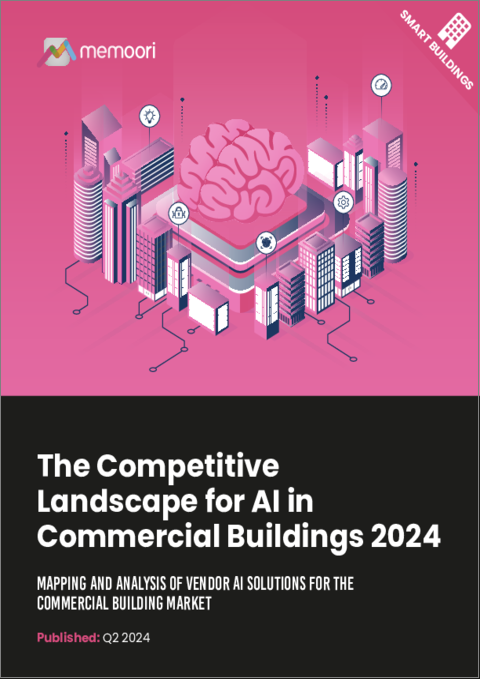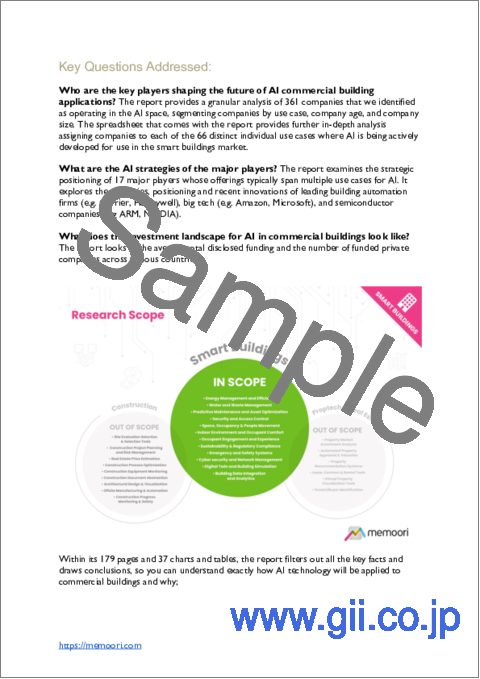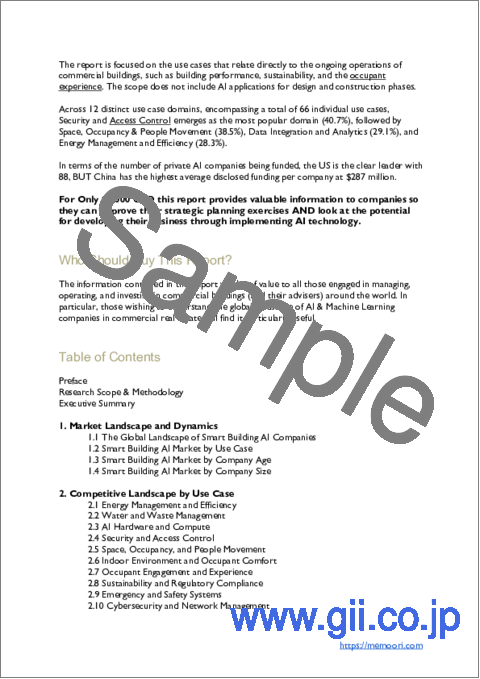|
|
市場調査レポート
商品コード
1462330
商業建築物向け人工知能 (AI) の競合情勢 (2024年)The Competitive Landscape for AI in Commercial Buildings 2024 |
||||||
|
|||||||
| 商業建築物向け人工知能 (AI) の競合情勢 (2024年) |
|
出版日: 2024年04月11日
発行: Memoori
ページ情報: 英文 179 Pages, 37 Charts, Spreadsheet, Presentation Slides
納期: 即日から翌営業日
|
全表示
- 概要
- 図表
- 目次
当レポートは、商業建築物向けベンダーAIソリューション市場の、2024年時点での最新のマッピングと分析結果です。
この新しい調査は、Memooriの2021年の人工知能 (AI) 市場分析をベースとして、よりスマートで持続可能性・応答性のより高い建築環境を実現させる、AIの全般的な能力と専門的用途の両方で生じた変化に注目して分析します。
詳細な分析により、スマート建築物向けAI企業の国際的状況をマッピングし、市場構造の明確なイメージを提供しています。読者は様々なAIアプリケーションの成熟度と可能性を評価し、業界を主導しているベンダーを特定することができます。
この報告書には、追加費用なしで、主要361社 (2021年の255社から42%増加) をAIの利用事例66件に分類したスプレッドシートが含まれています。姉妹レポートと合わせると、商業建築物におけるAIの影響について、これまで発表された中で最も完全な評価となります。
当レポートは、2部構成のレポートの第2弾です。第1弾では、AI技術や事業機会、利用事例について解説しています。どちらのレポートも、当社の2024年度のPremium Subscription Serviceに含まれており、大規模言語モデル (LLM) を活用して当社の全ての調査結果を照会できる、当社のChatbot AIM にもアクセスできます。
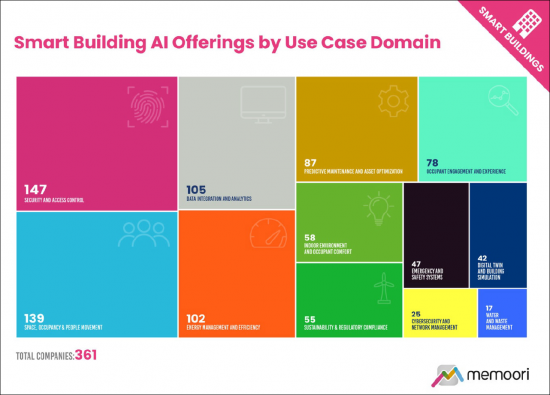
主な質問
- 未来の商業建築物向けAIを左右する主要企業はどれか? 当レポートでは、AI分野で事業を展開する企業361社を、利用事例別・社齢別・企業規模別に分類した上できめ細かく分析しています。レポート付属のスプレッドシートでは、スマートビルディング市場でAIが活発に開発されている66の個別の使用事例ごとに企業を分類し、さらに詳細な分析を行っています。
- 主要企業のAI戦略とは何か? 当レポートでは、AIの複数の利用事例にまたがって製品・サービスを提供する大手企業17社戦略的ポジショニングを調査しています。特に、大手ビルディングオートメーション企業 (Carrier、Honeywellなど) や大手ハイテク企業 (Amazon、Microsoftなど)、半導体企業 (GARM、NVIDIAなど) の戦略・ポジショニング・最近のイノベーションを調査しています。
- 商業建築物向けAIの投資状況はどうなっているのか? 当レポートでは、各国で開示された平均資金総額と、資金提供を受けた非公開会社の件数を調査しています。
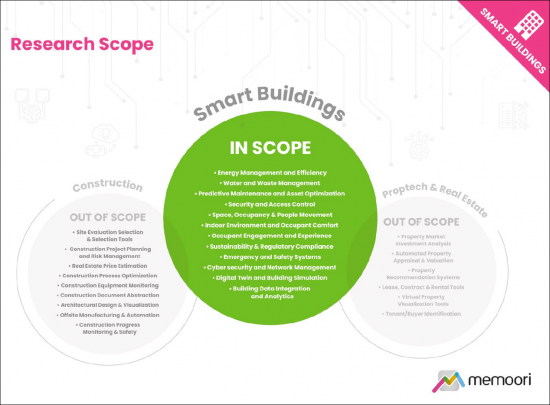
当レポートは179ページの文章と37点の図表で構成され、すべての重要な事実を抽出し、結論を導き出しているため、AI技術が商業建築物にどのように適用されるのか、またその理由を正確に理解することができます;
- 当レポートでは、商業建築物の現在の運営状況に直結する利用事例 - 建物の性能、持続可能性、居住者の体験など - に焦点を当てています。他方、設計・建設段階におけるAIの活用は対象としていません。
- 利用事例全体 (合計66件) の中の、全12種類の主要領域について見てみると、セキュリティとアクセス制御が最も人気のあるドメイン (40.7%) として浮上しています。次いで、空間・空室・人員移動 (38.5%)、データインテグレーション・分析 (29.1%)、エネルギー管理・効率 (28.3%) となっています。
- 資金提供を受けている非公開AI会社の数は、米国が88社で首位に立ち、飛びぬけた存在となっていますが、1社当たりの平均開示資金額は、中国が2億8,700万米ドルで最も高くなっています。
当レポートは、企業が戦略立案を改善し、AI技術を導入することでビジネスを発展させる可能性を検討できるよう、貴重な情報を提供します。
目次
序文
調査範囲・手法
エグゼクティブサマリー
第1章 市場情勢と動向
- 世界のスマートビルディング用AI企業の情勢
- スマートビルディング用AI用市場:利用事例別
- スマートビルディング用AI用市場:社齢別
- スマートビルディング用AI用市場:企業規模別
第2章 使用事例別の競合情勢
- エネルギー管理・効率
- 水道・下水管理
- AIハードウェア・コンピューティング
- セキュリティ・アクセス制御
- 空間・空室・人員移動
- 室内環境・居住者の快適性
- 居住者のエンゲージメントと体験
- 持続可能性と規制コンプライアンス
- 緊急・安全システム
- サイバーセキュリティ・ネットワーク管理
- デジタルツイン・建築物シミュレーション
- データインテグレーション・分析
第3章 主要企業の戦略的ポジショニング
- ビルオートメーション企業
- ABB
- Carrier
- Honeywell
- Johnson Controls
- Schneider Electric
- Siemens
- Major Tech Firms
- Amazon
- Cisco
- IBM
- Microsoft
- Samsung
- 大手半導体企業
- AMD
- ARM
- Intel
- NVIDIA
- Qualcomm
第4章 M&Aと投資
- 企業合併・買収 (M&A)
- 投資動向
- 地域別の投資動向
- 注目すべき投資取引
List of Charts and Figures
- Fig 1.0 - Research Scope
- Fig 1.1 - Regional Distribution of Smart Building AI Companies
- Fig 1.2 - AI & Machine Learning Use Cases in Smart Commercial Buildings
- Fig 1.3 - Smart Building AI Offerings by Use Case Domain
- Fig 1.4 - Most Commonly Served Individual Use Cases
- Fig 1.5 - Number of Use Cases Served by Company
- Fig 1.6 - Distribution of Smart Building AI Companies by Age
- Fig 1.7 - Median Company Age by Use Case Domain
- Fig 1.8 - Distribution of Smart Building AI Companies by Size
- Fig 1.9 - Average Company Size by Use Case Domain
- Fig 1.10 - Average Increase in Headcount
- Fig 2.1 - Notable Smart Building AI Companies
- Fig 2.2 - AI for Energy Management & Efficiency in Commercial Buildings
- Fig 2.3 - AI for Water and Waste Management in Commercial Buildings
- Fig 2.4 - AI for Predictive Maintenance and Asset Optimization in Commercial Buildings
- Fig 2.5 - AI for Security and Access Control in Commercial Buildings
- Fig 2.6 - AI for Space, Occupancy & People Movement in Commercial Buildings
- Fig 2.7 - AI for Indoor Environment and Occupant Comfort in Commercial Buildings
- Fig 2.8 - AI for Occupant Engagement and Experience in Commercial Buildings
- Fig 2.9 - AI for Sustainability & Regulatory Compliance in Commercial Buildings
- Fig 2.10 - AI for Emergency and Safety Systems in Commercial Buildings
- Fig 2.11 - AI for Cybersecurity and Network Management in Commercial Buildings
- Fig 2.12 - AI for Digital Twin and Building Simulation in Commercial Buildings
- Fig 2.13 - AI for Data Integration and Analytics in Commercial Buildings
- Fig 4.1 - Global Investment Landscape in AI for Commercial Buildings
This Report is a New 2024 Mapping and Analysis of Vendor AI Solutions for the Commercial Buildings Market
This new research builds on Memoori's previous 2021 Artificial Intelligence (AI) market analysis, exploring the immense progress that has occurred both in the capabilities of AI and the growing vendor landscape enabling smarter, more sustainable, and more responsive commercial buildings.
The in-depth analysis maps out the global landscape of smart building AI companies, providing a clear picture of the market's structure, and allows the reader to assess the maturity and potential of various AI applications and identify vendors shaping the industry.
It includes, at no extra cost, a spreadsheet that assigns all 361 companies identified (a 42% increase from the 255 companies we identified in 2021) to 66 distinct individual AI use cases. Together with its sister report it is by far the most complete assessment of the impact of AI on commercial buildings published to date.
It is the second in a 2-part series of reports, with the first report providing a review of AI technologies, opportunities and use cases. Both these reports are included in our 2024 Premium Subscription Service, which also gives access to our chatbot AIM, where you can query all our research using the power of Large Language Models (LLMs) .

KEY QUESTIONS ADDRESSED:
- Who are the key players shaping the future of AI commercial building applications? The report provides a granular analysis of 361 companies that we identified as operating in the AI space, segmenting companies by use case, company age, and company size. The spreadsheet that comes with the report provides further in-depth analysis assigning companies to each of the 66 distinct individual use cases where AI is being actively developed for use in the smart buildings market.
- What are the AI strategies of the major players? The report examines the strategic positioning of 17 major players whose offerings typically span multiple use cases for AI. It explores the strategies, positioning and recent innovations of leading building automation firms (e.g. Carrier, Honeywell), big tech (e.g. Amazon, Microsoft), and semiconductor companies (e.g ARM, NVIDIA).
- What does the investment landscape for AI in commercial buildings look like? The report looks at the average total disclosed funding and the number of funded private companies across various countries.

WITHIN ITS 179 PAGES AND 37 CHARTS AND TABLES, THE REPORT FILTERS OUT ALL THE KEY FACTS AND DRAWS CONCLUSIONS, SO YOU CAN UNDERSTAND EXACTLY HOW AI TECHNOLOGY WILL BE APPLIED TO COMMERCIAL BUILDINGS AND WHY;
- The report is focused on the use cases that relate directly to the ongoing operations of commercial buildings, such as building performance, sustainability, and the occupant experience. The scope does not include AI applications for design and construction phases.
- Across 12 distinct use case domains, encompassing a total of 66 individual use cases, Security and Access Control emerges as the most popular domain (40.7%), followed by Space, Occupancy & People Movement (38.5%), Data Integration and Analytics (29.1%), and Energy Management and Efficiency (28.3%).
- In terms of the number of private AI companies being funded, the US is the clear leader with 88, BUT China has the highest average disclosed funding per company at $287 million.
This report provides valuable information to companies so they can improve their strategic planning exercises AND look at the potential for developing their business through implementing AI technology.
WHO SHOULD BUY THIS REPORT?
The information contained in this report will be of value to all those engaged in managing, operating, and investing in commercial buildings (and their advisers) around the world. In particular, those wishing to understand the global landscape of AI & Machine Learning companies in commercial real estate will find it particularly useful.Table of Contents
Preface
Research Scope & Methodology
Executive Summary
1. Market Landscape and Dynamics
- 1.1. The Global Landscape of Smart Building AI Companies
- 1.2. Smart Building AI Market by Use Case
- 1.3. Smart Building AI Market by Company Age
- 1.4. Smart Building AI Market by Company Size
2. Competitive Landscape by Use Case
- 2.1. Energy Management and Efficiency
- 2.2. Water and Waste Management
- 2.3. AI Hardware and Compute
- 2.4. Security and Access Control
- 2.5. Space, Occupancy, and People Movement
- 2.6. Indoor Environment and Occupant Comfort
- 2.7. Occupant Engagement and Experience
- 2.8. Sustainability and Regulatory Compliance
- 2.9. Emergency and Safety Systems
- 2.10. Cybersecurity and Network Management
- 2.11. Digital Twin and Building Simulation
- 2.12. Data Integration and Analytics
3. The Strategic Positioning of Key Players
- 3.1. Building Automation Firms
- ABB
- Carrier
- Honeywell
- Johnson Controls
- Schneider Electric
- Siemens
- 3.2 Major Tech Firms
- Amazon
- Cisco
- IBM
- Microsoft
- Samsung
- 3.3. Major Semiconductor Firms
- AMD
- ARM
- Intel
- NVIDIA
- Qualcomm
4. M&A & Investment
- 4.1. Mergers and Acquisitions
- 4.2. Investment Trends
- Geographic Investment Trends
- Notable Investment Deals
